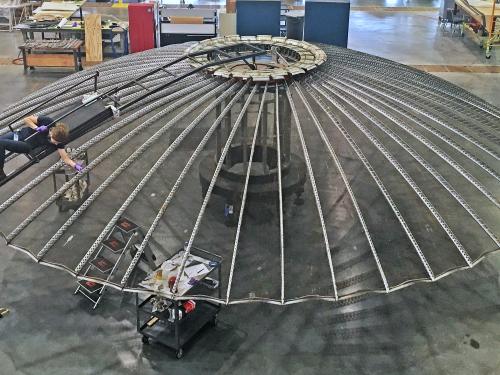

Stories of daring, stories of technological feats, stories of prevailing against the odds ... these are the stories we tell at the National Air and Space Museum. Dive in to the stories below to discover, learn, and be inspired.
Showing 11 - 20 of 39

December 21, 2022
Ambitious plans for gas stations in space could extend the lives of satellites

October 24, 2022
Conservator Rachel Greenberg reflects on the conservation and restoration of a 30-foot parabolic antenna that is part of a full-scale engineering model of the Applications Technology Satellite-6 (ATS-6). Read about the large umbrella-shaped antenna that now hangs from the ceiling in the new One World Connected gallery.

September 06, 2022
Our Museum recently acquired a first-generation HawkEye 360 Pathfinder satellite. The three Pathfinders and follow-on satellites form the first commercial satellite constellation ever to detect, characterize, and geolocate a broad range of radio frequency signals from transmitters on the ground and sea.

August 12, 2022
Curator Jennier Levasseur explores how astronauts have looked down at Earth during missions ranging from Apollo to the International Space Station expeditions.

August 09, 2022
Learn about three ways that satellites have led to a better understanding of how we affect our environment.
August 07, 2022
Over time, Earth was became one connected planet—one global neighborhood.

July 28, 2022
When you hear the term “space archaeology” you might envision a khaki-clad astronaut excavating the Moon. But actually, space archaeologists are actually Earth-bound researchers who use satellite and other aerial imagery to assist in archaeological applications right here on our home planet. This imagery is used to find new archaeological sites, track changes on already discovered ones, and even helps fight looting.

January 14, 2021
Satellites from NASA and private companies are making headlines. What’s their history and how might their future affect space and life here on Earth?

April 01, 2020
On the evening of April 1, 1960, President Dwight Eisenhower saw the first image sent back from space by the Television InfraRed Observation Satellite (TIROS) 1 weather satellite—shaped, as some quipped, like “an enormous hatbox.”

November 21, 2018
John F. Kennedy's assassination on November 22 and his funeral on November 25 occurred at a moment in which "live via satellite" was beginning to enter the Cold War world. Satellites broadcast information about his death around the world in a way never possible before.